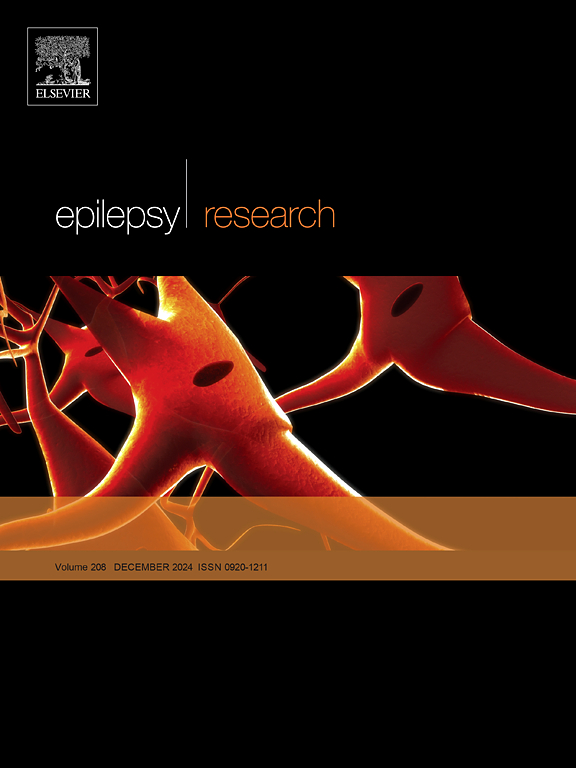迷走神经刺激治疗耐药癫痫的长期预后和预测因素:来自韩国国家医院联盟的真实世界证据。
IF 2
4区 医学
Q3 CLINICAL NEUROLOGY
引用次数: 0
摘要
目的:本研究旨在利用真实世界数据评估迷走神经刺激(VNS)治疗耐药癫痫(DRE)的长期疗效和预后因素。方法:我们纳入了2005年至2018年在韩国9家国立医院接受VNS植入的189例DRE患者。从医疗记录中收集手术前后一年每季度一次的癫痫发作频率数据以及手术后四年每年一次的癫痫发作频率数据。通过与国家健康保险数据的联系,评估了手术前后四年的卫生资源利用趋势。我们进行了中断时间序列分析,以检查手术前后一年癫痫发作频率的趋势。结果:VNS植入后1年内癫痫发作频率呈下降趋势(27.5% %)和上升趋势(3.8% %),此后3年疗效无明显变化。脑电图局灶尖峰伴继发性双侧同步(SBS)患者的应答率较高(调整优势比(aOR)= 3.06[1.36-6.90]),而lenox - gastaut综合征患者的应答率较低(aOR=0.38[0.15-0.94])。在四年的随访中,6.0 %的患者在某一时刻实现了一年的癫痫发作自由。在8年的时间里,术前抗癫痫药物(asm)的数量有增加的趋势,术后保持在5个[4-6]的中位数。虽然手术后总医疗费用和癫痫相关费用趋于下降,但ASM费用继续增加。结论:VNS对四分之一的DRE患者有实质性的益处,提供了癫痫发作自由的机会。然而,VNS的疗效在最近引入的药物治疗的疗效范围内,并没有导致ASM负担的减少。伴SBS的局灶性尖峰是对VNS有利反应的潜在生物标志物。本文章由计算机程序翻译,如有差异,请以英文原文为准。
Long-term outcome and predictors of vagus nerve stimulation for drug-resistant epilepsy: Real-world evidence from the Korean national hospital consortium
Objective
This study aimed to assess the long-term outcome and prognostic factors of vagus nerve stimulation (VNS) for drug-resistant epilepsy (DRE) using real-world data.
Method
We included 189 DRE patients who underwent VNS implantation between 2005 and 2018 at nine national hospitals in Korea. Seizure-frequency data obtained quarterly one year before and after surgery and annually up to four years after surgery were collected from medical records. Health resource utilization trends over the four years preceding and following surgery were assessed through linkage with national health insurance data. We performed interrupted time series analysis to examine the trend in seizure frequency before and after one year following surgery.
Results
The seizure frequency exhibited a decreasing trend in 27.5 % and an increasing trend in 3.8 % during the first year following VNS implantation without a significant change in efficacy over the subsequent three years. Patients with focal spikes with secondary bilateral synchrony (SBS) in electroencephalography had a higher responder rate (adjusted odds ratio (aOR)= 3.06 [1.36–6.90]), whereas those with Lennox-Gastaut syndrome had a lower responder rate (aOR=0.38 [0.15–0.94]). One-year seizure-freedom was achieved in 6.0 % of patients at some point during the four-year follow-up. Over an eight-year period, the number of antiseizure medications (ASMs) tended to increase before surgery and remained at a median of 5 [4−6] after surgery. While the total medical and epilepsy-related costs tended to decrease after surgery, the ASM cost continued to increase.
Conclusion
VNS was substantially beneficial for one in four patients with DRE, offering the chance of seizure-freedom. However, the efficacy of VNS fell within the efficacy range of recently introduced medical treatments and did not lead to a decrease in the ASM burden. Focal spike with SBS is a potential biomarker for a favorable response to VNS.
求助全文
通过发布文献求助,成功后即可免费获取论文全文。
去求助
来源期刊

Epilepsy Research
医学-临床神经学
CiteScore
0.10
自引率
4.50%
发文量
143
审稿时长
62 days
期刊介绍:
Epilepsy Research provides for publication of high quality articles in both basic and clinical epilepsy research, with a special emphasis on translational research that ultimately relates to epilepsy as a human condition. The journal is intended to provide a forum for reporting the best and most rigorous epilepsy research from all disciplines ranging from biophysics and molecular biology to epidemiological and psychosocial research. As such the journal will publish original papers relevant to epilepsy from any scientific discipline and also studies of a multidisciplinary nature. Clinical and experimental research papers adopting fresh conceptual approaches to the study of epilepsy and its treatment are encouraged. The overriding criteria for publication are novelty, significant clinical or experimental relevance, and interest to a multidisciplinary audience in the broad arena of epilepsy. Review articles focused on any topic of epilepsy research will also be considered, but only if they present an exceptionally clear synthesis of current knowledge and future directions of a research area, based on a critical assessment of the available data or on hypotheses that are likely to stimulate more critical thinking and further advances in an area of epilepsy research.
 求助内容:
求助内容: 应助结果提醒方式:
应助结果提醒方式:


